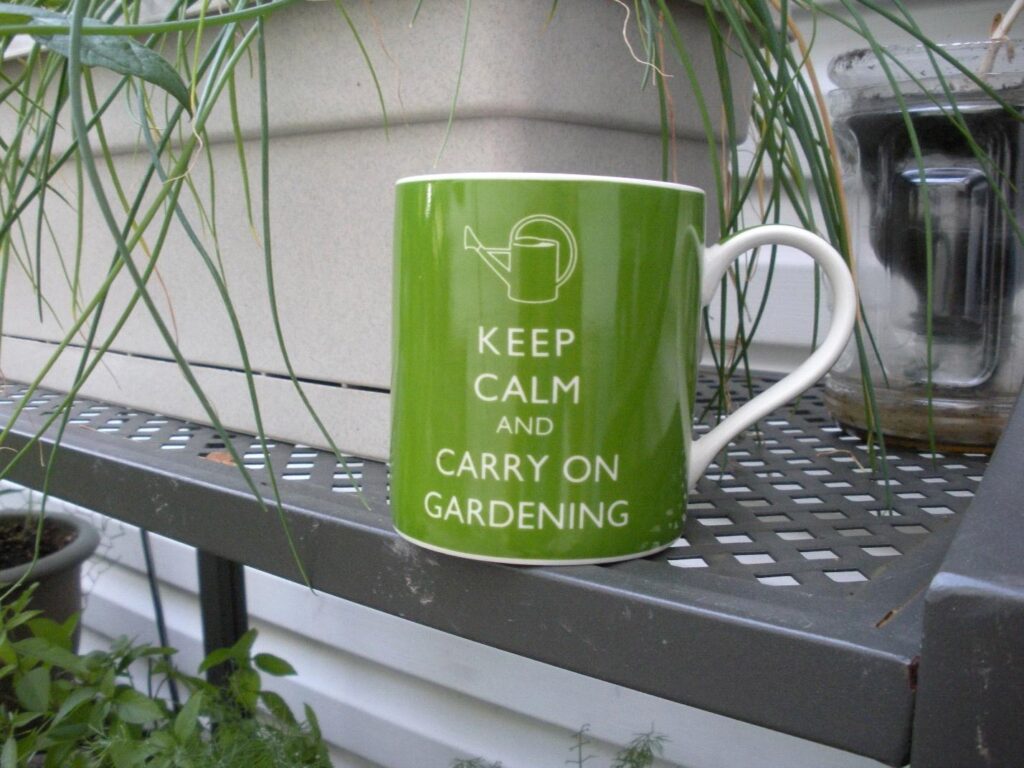The DTE Notebook for the Urban Organic Vegetable, Herb and Flower Gardener.
Common Garden Issues
Article and photos by Rob Danforth.
At one time or another, all gardens will experience some or all of the following (but not all at the same time), so we must be vigilant: poor soil, insects (harmful & helpful), critters (harmful & helpful), diseases (harmful & harmful!), under or over watering, nutrient deficiencies, nutrient excesses, poor pollination, and blossom drop.
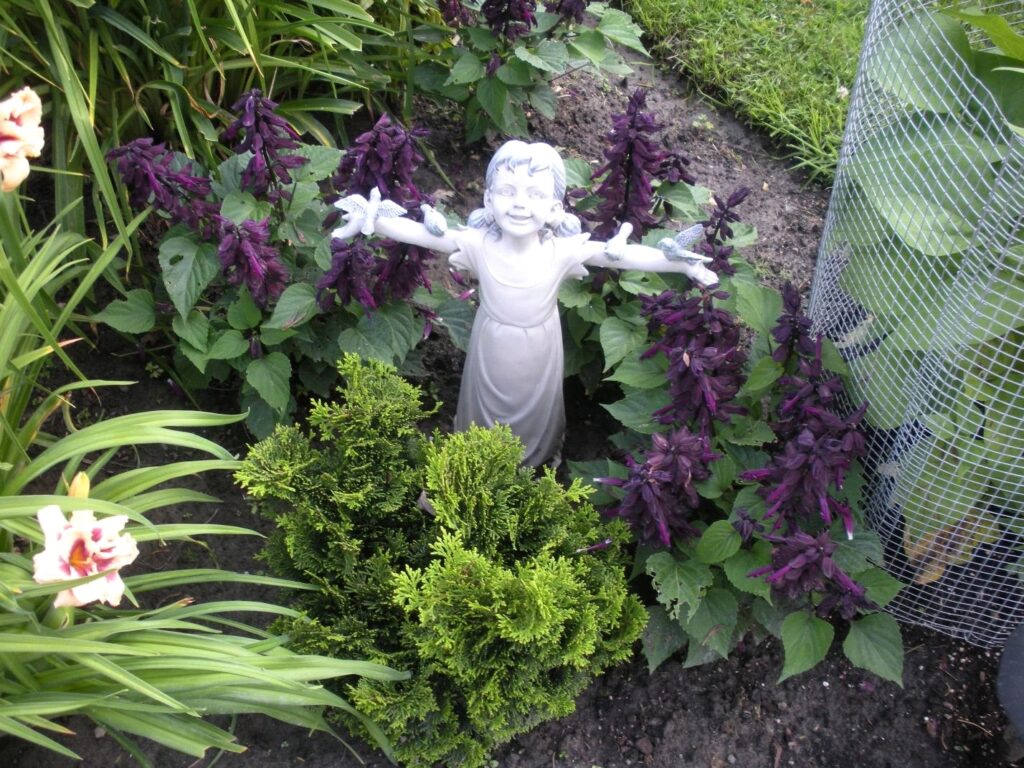 (Photo: Biodiversity and Hardware Cloth rabbit proof fence around bush beans).
(Photo: Biodiversity and Hardware Cloth rabbit proof fence around bush beans).
Good “garden soil” (not ground soil) and “potting mix” (no soil), both with added compost, are the foundations of all successful gardening! A growing medium affects the flavours of plants grown in it (e.g., a merlot red wine from France and the same cultivar from Australia or from Mexico taste different); soil structure affects both moisture retention (e.g. clay soils drain too slowly; sandy soils drain too quickly), and plant growth (e.g. carrots will twist and fork in dense, hard packed soils). A good growing medium drains well, retains moisture, is friable (loose & workable – you can work your finger into the medium without causing pain), and contains all the nutrients that plants need to thrive.
Plots and large containers need “garden soil” with compost & Mycorrhizal fungus. Portable and elevated containers need “potting mix” with Mycorrhizal fungus & ⅓ to ½ compost by volume. Tip: Potting mix comes with fewer nutrients so add a significant amount of compost.
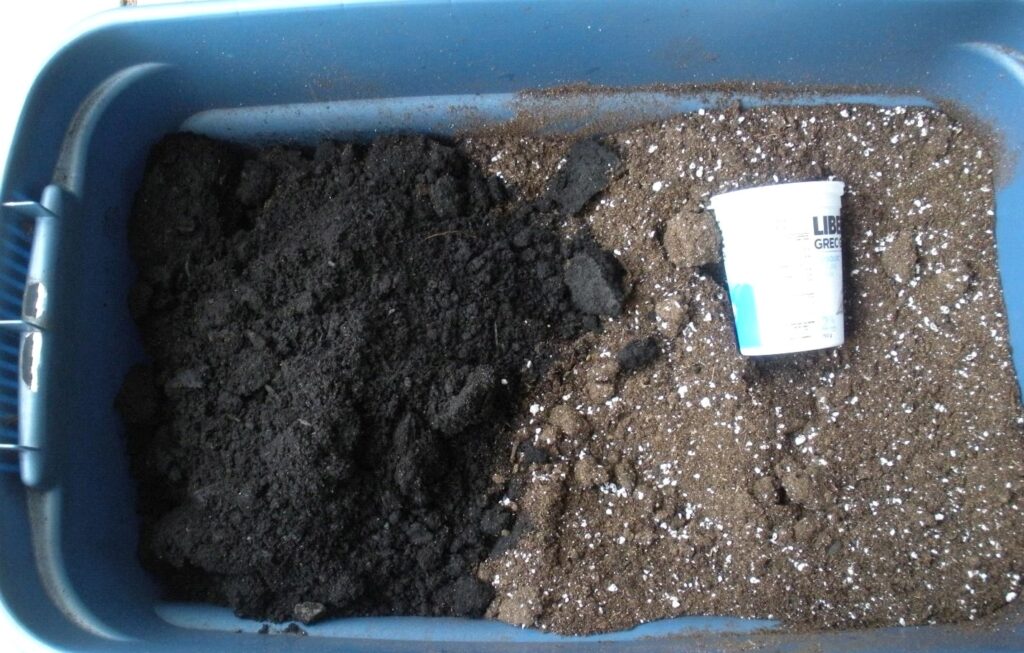
(Photo: dark rich composted sheep manure and light, not so rich potting mix)
Soil maintenance involves aerating (loosening) soils when they are condensed and fertilizing twice a year (fall or early spring, & mid season) with compost, well composted farm animal manure (chicken, sheep, cow, or horse), or organic liquid or granulated fertilizer.
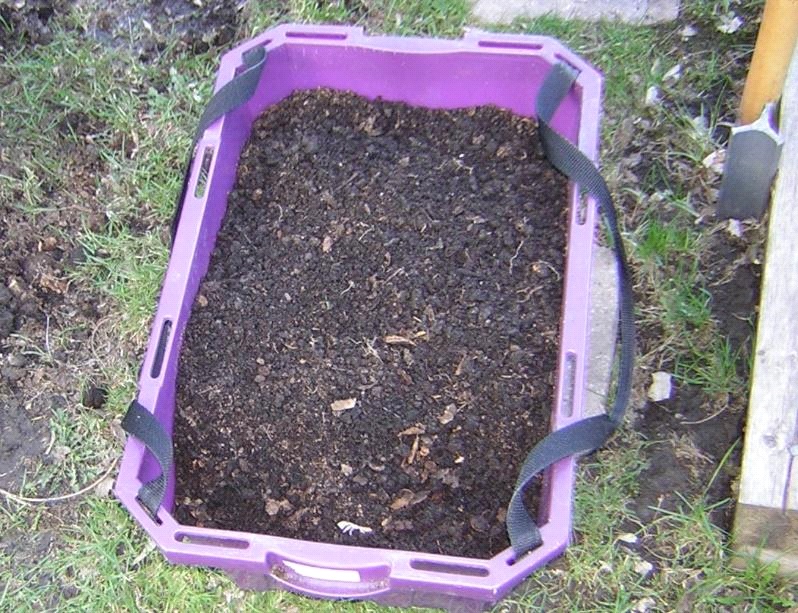
(Photo: screened homemade compost)
Tip: “Compost” is highly recommended for its many benefits to soils and potting mixes. Compost neutralizes disease over time, balances pH, adds all sort of nutrients, from A to Z, retains moisture, and makes soil friable and root friendly. “Chemical fertilizers” have only a few targeted nutrients in a concentrated, quick release form. To amend the soil fully, during the season you will have to compensate for whatever these chemical fertilizers won’t add.
Insects Harmful and Helpful
Harmful insects eat the plants we eat (most weeds tend not to be on their menu when there are veggies available!!). Common harmful bad actors are Aphids, Caterpillars, Colorado Potato beetles, Earwigs, Flea beetles, Leaf miners, Japanese beetles, Squash vine borers, as well as Slugs, & Snails. The best solution is barriers: bug netting, row covers, polytunnels, cloches, crushed egg shells (snails & slugs), copper sheets (snails & slugs), aluminum foil stalk wrap (squash vine borer), and cutworm sleeves. The only spray I use is soap (pure Castille soap) and water with a plain water rinse after 10 minutes (recommended by Ed Lawrence). This kills soft bodied insects but not adult beetles (e.g., Cucumber, Colorado, & Japanese beetles) which have their own hard shell body armor. Drown the adults in a cup of soapy water, or put on a glove and squish all the adults … except the Japanese beetle: drown this one! Squishing the Japanese beetle could release pheromones (a sort of perfume) that will call other Japanese beetles to come hither to feed and to mate!
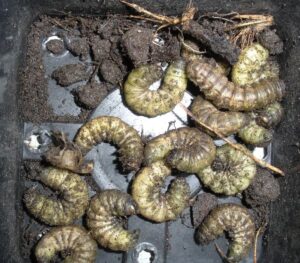
(Photo: Soil Grubs)
Helpful insects pollinate our plants (e.g., many kinds of bees, flies, mosquitos, moths) and assist in making compost (e.g., earwigs, sow bugs). Do offer bug restaurants in the form of continuously blooming flowers from spring to fall, and if possible, construct some bug hotels.
Helpful Insect Predators eat the harmful insects, e.g.: Assassin Bug, Big Eyed Bug, Damsel Bug, Damselflies, Dragonflies, Fireflies, Ground Beetles, Hover Flies (Syrphid), Lacewing Flies, Ladybugs, Mantids, Minute Pirate Bug, Robber Flies, Rove Beetles, Soldier Beetles, Spiders, Predatory Stink Bug, Tachinid Flies, Tiger Beetles, and Wasps. Encourage them to come and dine by adding flowers that attract the harmful and helpful bugs, and by not killing every bug you find suspicious – let the predators feed and nourish their young!
Critters Harmful and Helpful
Harmful critters create problems in the garden: cats, deer, dogs, groundhogs, mice, rabbits, raccoons, rats, squirrels, voles. Tip: cat and dog poop have harmful pathogens, and their feces must be removed. Dog urine and Tom cat spray will burn and kill all vegetation.
Recommended defense: barriers (e.g., bird or bug netting, row covers, chicken wire, hardware cloth). Not recommended: live trapping, plastic raptors, sonic discouragers, chemical sprays, noisemakers, powders, human or pet hair or urine, etcetera. These tend to be more trouble than they are worth. Remember, hunger rules and traps tend to catch more than you intended (e.g., rat traps also catch chipmunks and birds; groundhog traps also catch rabbits, squirrels, and skunks).
Helpful critters are the insect eaters and rodent chasers: bats, birds, dogs, skunks, snakes, toads, and tree frogs. Let them work!
Diseases: Bacteria, Fungus, and Viruses
Bacteria start as a dimple & and create serious discolouration, fungus has furry or fruiting bodies & often light or dark colouration on leaves (like the furry deposits on products that have been in the fridge too long), and viruses produce very unusual leaf color & odd structural variations.
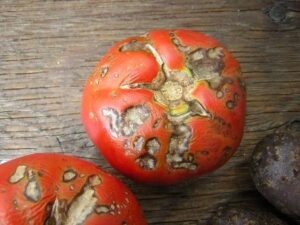
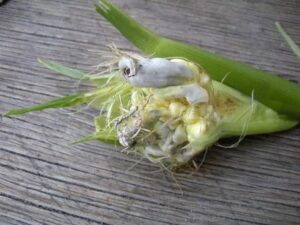
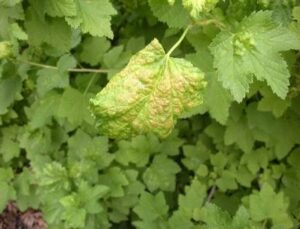
(Photos: Bacteria on tomatoes, Fungus “corn smuts”, and Mosaic Virus on white currants)
Bacteria on produce (e.g., tomato tops, & fruit that touches ground soil or has soil splash), appears at first as a dimple and then as black color with obviously wasted areas. Protect fruit from soil bacteria with mulch, and water only the plant roots – not the leaves, fruit, weeds, or unproductive areas. A thirsty plant needs a drink, not a shower!
Tomato blight on leaves & stalks starts as small brown and yellow spots on leaves and stalks – remove & green bin all affected parts, and all fallen debris; rotate plants to new locations and new soil for the next 2 to 3 seasons and apply significant amounts of compost.
White or Grey Powdery mildew on leaves – spray milk & water 50/50, or baking soda & water – do not rinse. This retards the mildew, but does not stop it. It is OK to compost the waste.
Mosaic virus via cucumber beetle or aphids – destroy entire plant: roots, stalks, leaves, spoiled fruit, and any fallen debris. Place the plant in the green bin, or yard waste – do not compost, and do not save seed. Note: the virus will not harm people! However, do not let it get a foothold in your garden. It ruins plants.
Under/Over Watering
Under watering causes plants to wilt or droop as water in the plant makes leaves and stalks firm – like air in a balloon. Water the roots only, and the plant should recover in an hour or two. “Blossom end rot” in tomatoes and peppers (bottom end turns brown or black and starts to rot) is due to irregular watering which stops the uptake of calcium to the fruit. These plants do not swim so soil must be well drained; however, the soil must not be allowed to dry out. This problem is easy to identify and treat. Finger check daily and water on demand.
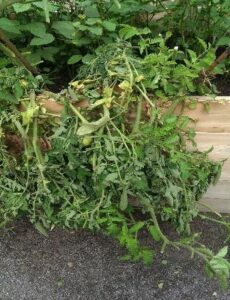
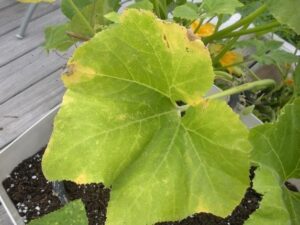
Over watering or lack of good drainage leads to drowning – plants need moisture and air at the roots and too much water eliminates air. Leaves will turn yellow, usually from the bottom first, but not always. This problem is slow to appear and plants are very slow to recover since the damage is more severe. Excess water has to be removed as soon as possible. Re-potting may be necessary.
Nutrient Deficiencies and Nutrient Excesses
Deficiencies: when the soil or potting mix does not have enough of one or more of the nutrients that plants need ( e.g. Nitrogen, Phosphorus, Potassium, Calcium, Magnesium, Sulphur, Iron – to name only a few!), either because they have been consumed by plants or washed away by water, the problem shows up in noticeable discoloration in the leaves (yellow, tawney, white-ish, or dark, almost purple – usually starting from the central vein in a leaf), as well as in stunted growth. Figuring out which nutrient may not be the best use of your time, because yellow color is common for a number of missing nutrients and also for drowning and for spent plants. In addition, you may not be able to buy a specific nutrient to add to the growing medium.
Solution: add 4 cm compost or composted farm animal manure, or add organic liquid or granulated fertilizer according to instructions. Recovery will be slow until water soluble nutrients replenish the soil and reach the plant. Tip: chicken manure with NPK of 4-6-8 + calcium will react a little faster (apply small amounts, rake it under, and water it in) as well as ¼ cup of powdered milk + Epsom salts (50/50) around each tomato plant.
Excesses happen when too many quick-release, water-soluble nutrients (e.g., high NPK numbers) are added. Excess water-soluble nutrients can burn food plants and most of them will only get wasted anyway with the next rain or watering – so, save your money. Compost and well composted farm animal manure have low NPK numbers. They are slow-release, they continue to give day by day, and they are non-burning. Avoid fresh manure; it burns plants and may contain pathogens harmful to gardeners.
Too much nitrogen (N), for example, produces very large green growth with little to no fruit at all. In the 1970’s, my 15 sweet green pepper plants, fed with a large amount of mushroom compost grew waist high with beautiful green foliage, and produced a grand total of 4 peppers (I foolishly thought that if a little was good, then a lot was excellent). A garden colleague’s sprouting broccoli plant grew to shrub size on too much N, but never sprouted.
Solution: To decrease an excess, water it away, or relocate the plant to new garden soil or potting mix. (Note: head broccoli is the kind sold in supermarkets; sprouting broccoli produces many small florets, like a head divided into pieces, growing on various parts of the plant. The gardener cuts enough for a meal and lets the rest grow on).
Pro-active Plant Stress & Disease Management
to reduce bug attacks & blossom drop.
Two important facts: #1 stressed plants attract feeding insects – they are nature’s janitors and like sharks in the ocean, they go after the weak, the sick, and the damaged. #2 Plants that are stressed will jettison their blossoms to save energy; flower and seed production require a lot of energy and can further weaken an already stressed plant.
- Reduce weed pressure. Weeds compete for the available water-soluble plant food and contribute to nutrient depletion (remove weeds, compost them with seed heads removed, & add mulch to the garden to deprive weeds of sunlight)
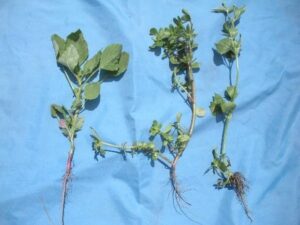
(Photo: Lambs Quarters, Purslane, and Galinsoga or “Quick Weed”)
- Follow watering guidelines (water roots only, determine which plants require wet & dry periods and those which need a continually moist soil or growing medium, — no swamps, ever). For example, vine plants (tomatoes, squashes, cucumbers, …) and all salad greens need well drained but continually moist soil.
- If possible, rotate annual plants to new areas each season on a 3 to 4 year cycle to allow the nutrients to be replenished, and the bugs and diseases to vacate the premises. This is important for all plots, raised beds, and large containers in which the same soil is re-used year after year – even with the addition of compost or composted farm animal manure.
- Ensure sun requirements (aerate/trim bushy plants, & sun boost or sun screen as needed). Not all plants need the same sun strength. For example, herbs will tolerate part shade, peppers need a hot sun, tomatoes need a moderate sun, and lettuce and cilantro/coriander benefit from a weak summer sun or part shade (hide them behind other plants so the sunlight is filtered or dappled).
- Reduce wind borne diseases, wind destruction, & wind drying (set a windbreak).
- Keep leaves & fruit from touching the soil and reduce soil splash up onto leaves (trim lower leaves and add mulch to reduce exposure to soil borne diseases).
- Aerate/loosen all dense soils for improved air & water penetration (be careful not to cut roots).
- Maintain air circulation around, between, and through plants to reduce humidity and reduce the risk of fungus and bacteria (thin bushy plants)
- Fertilize twice a year (fall or early spring & mid-season) with compost, composted farm animal manure, or organic liquid or granulated fertilizer. For the last two, a small amount with every watering is much better than a large dose at any one time.
Reactive Plant Stress & Disease Management
#1. Remove all diseased plant material as soon as possible and clean up all debris from the soil. Choose a dry day – if the whole plant is infected, put a bag over it before removing – place fruit, leaves, stalks, & roots in the green bin or yard waste. Do not compost or save seed from diseased plants.
#2. Clean garden tools and gloves to avoid disease transfer. Use hot soapy water, rubbing alcohol, diluted bleach, or hand sanitizer.
#3. Leave powdery mildew in place but spray it with milk or baking soda and water. Do not rinse. Note: these will slow the spread but will not eliminate the mildew. It is safe to compost this plant waste. (Photo: Powdery Mildew)

#4. Fertilize more often if nutrient deficiencies show up, but be cautious of nutrient build up which can lead to excess.
#5. If possible, rotate plants to new areas each season on a 3 to 4 year cycle (recommended).
- All plants (including weeds) consume different nutrients in varying quantities, at different times and at different depths.
- Bugs and diseases inhabit soil near favored plants – and they will rise again!
- All soils and potting mixes become exhausted as plants consume nutrients!
Simple rotation for soil recovery: 1st season, greens (spinach, lettuce, mesclun, …), 2nd fruits (cucumbers, tomatoes, …), 3rd roots (beets, carrots, …), and 4th legumes (peas, beans, peanuts, lupins, Dutch white clover, …). Plus, 4 cm of compost, twice each season.
These issues are quite common for all gardens and weather can change everything for better or for worse. Too much rain, little sun, and stiff breezes can discourage insects, critters, and plants. This can lead to fewer pollinators and insect predators, hungry insects and critters, and stressed plants. While a farmer with acres of plants is at the mercy of the weather, an urban gardener has a few more protective options due to the limited size of the gardens. Regardless, in a biologically diverse garden, some plants will survive and flourish – celebrate these!
Happy Gardening!
